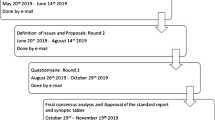Abstract
This article provides a glimpse into the future of the Liver Imaging Reporting and Data System (LI-RADS), discussing the immediate and long-term plans for its continuing improvement and expansion. To complement the Core and Essentials components of the latest version of LI-RADS, a comprehensive manual will be released soon, and it will include technical recommendations, management guidance, as well as reporting instructions and templates. In this article, we briefly review the process by which LI-RADS has been developed until now, a process guided by a variable combination of data, expert opinion, and desire for congruency with other diagnostic systems in North America. We then look forward, envisioning that forthcoming updates to LI-RADS will occur regularly every 3 to 5 years, driven by emerging high-quality scientific evidence. We highlight some of the key knowledge and technology gaps that will need to be addressed to enable the needed refinements. We also anticipate future expansions in scope to meet currently unaddressed clinical needs. Finally, we articulate a vision for eventual unification of imaging system for HCC screening and surveillance, diagnosis and staging, and treatment response assessment.
Similar content being viewed by others
Abbreviations
- AASLD:
-
American Association for the Study of Liver Diseases
- CEUS:
-
Contrast-enhanced ultrasound
- CT:
-
Computed tomography
- ECA:
-
Extracellular agents
- ICC:
-
Intrahepatic cholangiocarcinoma
- HBA:
-
Hepatobiliary agents
- HCC:
-
Hepatocellular carcinoma
- LI-RADS:
-
Liver Imaging Reporting and Data System
- MRI:
-
Magnetic resonance imaging
- OPTN:
-
Organ Procurement and Transplantation Network
References
American College of Radiology (2017) Liver imaging reporting and data system. Latest version retrieved from http://www.acr.org/quality-safety/resources/LIRADS
OPaTN (2017) OPTN/UNOS policy 9: allocation of livers and liver-intestines. http://optn.transplant.hrsa.gov/ContentDocuments/OPTN_Policies.pdf-nameddest=Policy_09. Accessed 4 Mar 2017
Bruix J, Sherman M (2011) Management of hepatocellular carcinoma: an update. Hepatology 53:1020–1022
Darnell A, Forner A, Rimola J, et al. (2015) Liver imaging reporting and data system with MR imaging: evaluation in nodules 20 mm or smaller detected in cirrhosis at screening US. Radiology 275:698–707
Kim TK, Lee KH, Jang HJ, et al. (2011) Analysis of gadobenate dimeglumine-enhanced MR findings for characterizing small (1–2-cm) hepatic nodules in patients at high risk for hepatocellular carcinoma. Radiology 259:730–738
Tang A, Cruite I, Mitchell DG, Sirlin CB (2017) Hepatocellular carcinoma imaging systems: why they exist, how they have evolved, and how they differ. Abdom Radiol (NY). https://doi.org/10.1007/s00261-017-1292-3
Han KH, Kim DY, Park JY, et al. (2013) Survival of hepatocellular carcinoma patients may be improved in surveillance interval not more than 6 months compared with more than 6 months: a 15-year prospective study. J Clin Gastroenterol 47:538–544
Santi V, Trevisani F, Gramenzi A, et al. (2010) Semiannual surveillance is superior to annual surveillance for the detection of early hepatocellular carcinoma and patient survival. J Hepatol 53:291–297
Trevisani F, De Notariis S, Rapaccini G, et al. (2002) Semiannual and annual surveillance of cirrhotic patients for hepatocellular carcinoma: effects on cancer stage and patient survival (Italian experience). Am J Gastroenterol 97:734–744
Tanabe M, Kanki A, Wolfson T, et al. (2016) Imaging outcomes of liver imaging reporting and data system version 2014 category 2, 3, and 4 observations detected at CT and MR imaging. Radiology 281:129–139
Santillan C, Fowler K, Kono Y, Chernyak V (2017) LI-RADS major features: CT, MRI with extracellular agents, and MRI with hepatobiliary agents. Abdom Radiol (NY). https://doi.org/10.1007/s00261-017-1291-4
Cruite I, Santillan C, Mamidipalli A, et al. (2016) Liver imaging reporting and data system: review of ancillary imaging features. Semin Roentgenol 51:301–307
Chernyak V, Tang A, Flusberg M, et al. (2017) LI-RADS(R) ancillary features on CT and MRI. Abdom Radiol (NY). https://doi.org/10.1007/s00261-017-1220-6
Author information
Authors and Affiliations
Corresponding author
Rights and permissions
About this article
Cite this article
Sirlin, C.B., Kielar, A.Z., Tang, A. et al. LI-RADS: a glimpse into the future. Abdom Radiol 43, 231–236 (2018). https://doi.org/10.1007/s00261-017-1448-1
Published:
Issue Date:
DOI: https://doi.org/10.1007/s00261-017-1448-1




